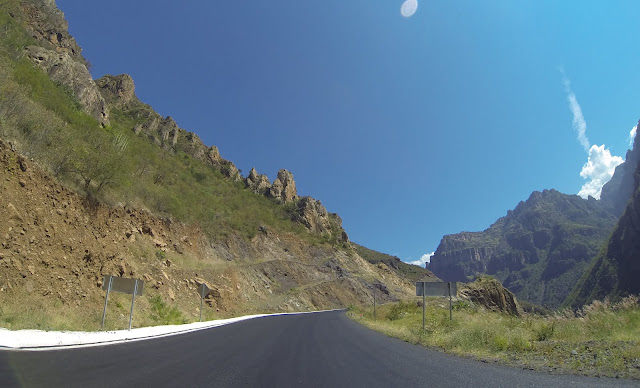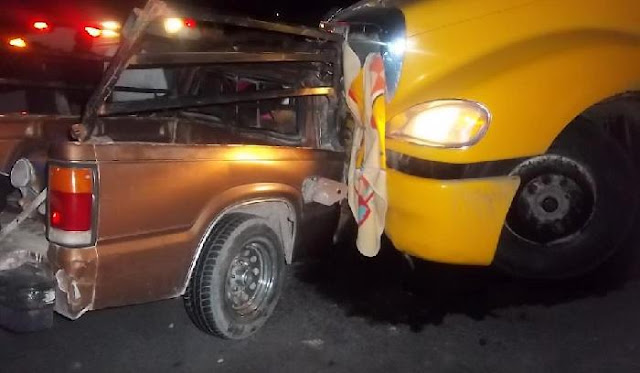 |
| Overlooking Hermosillo atop the Cerro de Campana Photo: Jim Foreman |
Story by Jim Foreman
According to Far
and Wide Travel, each year, over 41 million people arrive in Mexico to
enjoy the incredible beaches, warm weather, and excellent hospitality. Of
course, those numbers are down in 2020 and 2021 for obvious reasons.
Still, Mexico is rated the 7th top tourist destination worldwide.
Most of Mexico's visitors
arrive by plane to Cancun, Puerto Vallarta, Mazatlán, Los Cabos, and Mexico
City. Certainly, Mexican cruises originating from the US gulf states and
California account for a large number of visitors, too.
Airplanes and cruise ships are
wonderful ways to enter Mexico. For those arriving from Europe, Asia,
South America, and Oceana, flying is the only practical way to do
so.
Fortunately, for those in the
USA and Canada, we have another option. Every year millions of drivers
and riders visit Mexico. Of course, this includes a massive number of
snowbirds that travel from Canada and the USA to escape winter.
Those who embrace the gift of
time realize the benefits that come with overland travel. It seems to be a recent phenomenon to
neurotically cram two weeks of vacation into a long weekend. The creation of the term “FOMO” (Fear Of
Missing Out) illustrates this beautifully. Whatever pop culture calls it these
days, anxiety gets fed by multiple sources.
These include despotic legislation, heavy-handed isolation mandates in
the name of health, and a constant drone of anger and fear-mongering from news
media.
There’s a bright spot in all of
this madness. Pack one (and only one) bag
of spare clothes, top off your fuel tank, and head south to a land that is
still operating in a realm of sanity and humanity. Yes, that’s Mexico.
6 Reasons to drive through Mexico
1. Taking your Car, RV, or Motorcycle into Mexico is Super Easy
If you’re only
traveling to Baja California or the northern part of Sonora, it’s even easier. If you’re staying only a weekend to places
like Ensenada, San Felipe, Rocky Point, or San Carlos, travelers only need
their passports and Mexican car insurance.
If you’re staying longer but only in Baja or Northern Sonora, you only
need to add a tourist visa as you cross the border. Traveling beyond these ‘Hassle-Free Zones’ as
they’re called in Mexico? Then, drivers must
also get a TVIP (or TIP) (Temporary Vehicle Import Permit). The TVIP allows your vehicle to travel
throughout Mexico on your non-Mexico plate.
To reiterate, anytime you leave the USA or Canada, you must have a
Passport. Canadians understand this, but
many Americans, out of ignorance, like to argue this point. Also, anytime your vehicle is in Mexico, you MUST
have Mexican Insurance (or up to $500,000USD in cash to pay restitution in the
event of an accident). Drivers in a
collision without coverage or enough insurance enjoy a luxury holiday in a Mexican
jail until full restitution is made.

Boca de Tomatlan, Mexico Photo: Robby McCullough
2. The Mexican Countryside is
Beautiful

Driving through Mexico is a pleasure
in itself. Mountains, seas, forests, and
deserts mix with pre-Hispanic, colonial, and contemporary history. Every town has a story, and everywhere you
go, people are genuinely nice. Mexicans
have a keen ability to read people. If
you’re a good person, good people will gravitate to you. If you’re not, well, you should probably stay
bunkered down at home.

Puente Balluarte Photo: Jim Foreman
3. Mexico’s Autopista system is very
good (for the most part)

Mexico’s equivalent of
interstates is called the Autopista. It’s
also sometimes known as the Cuota or toll roads. Most Mexican states have invested heavily in
modernizing and maintaining these high-speed roadways connecting major
cities. While the cost can be
significant, they enable travelers to quickly and safely get through Mexico. Autopistas are also patrolled by the Angeles
Verdes or Green Angels. They are state-paid
mechanics who assist motorists in the event of a breakdown, tire puncture, or
empty fuel tank.
4. On the Highway, Speeds are Rarely Enforced
In Mexico, when on long stretches
of highway, you can travel at whatever speed you want. The caveat is that you have to own it. If you crash, it’s on you. Do pay careful attention to signs indicating
sharp turns or construction. Also, take
heed to this next thing, as this is very important. Drive in the right lane and use the left lane
only for passing. If someone wants to
pass, get out of the way and let them. Stay
alert for road hazards, and don’t drive outside of the city at night.
Now, as you get close to a town,
slow down to the posted speed limit.
Federal and Municipal police are nearly always near town limits to bust
people racing into their city. Slow down
and set the cruise control to the posted speed, so you’re not tempted to blast
through. You’ll thank me as you wave to
the cop waiting for speeders with their radar gun.

El Fuerte - Birthplace of the real 'Zorro' Photo:Jim Foreman
5. See and Experience Sights and
Wonders Along the Way

You’ve heard the saying many
times, “It’s not the destination. It’s the journey that counts.” This is especially
true in Mexico. Mexico is a huge
country. It’s the 14th
largest country by landmass. It’s so big
that it matches the size of nearly all of western Europe. Just like Europe, Mexico’s terrain is as diverse
as its people. Mexico is recognized as one of the six cradles
of civilization. Evidence of this is
found throughout the country. The
Mexican government recognizes 68 national languages. While Spanish is most dominant, English and
then German also are pretty common. In
fact, 63 of the officially recognized languages are native to Mexico.
If one believes in diversity
beyond political lip-service, there’s no better place than Mexico.
For example, While nobody knows
exactly how many pyramids are in Mexico, there are over three dozen known
structures throughout the country. Mexico
also has the only known circular pyramids in the world. Think of the hat worn by the group, Devo.
Over 15 of these pyramids are
easily reached by car. Explore many of them with a local guide or interpreter. Absent are the throng of tourists brought in
by coach bus each day.
There are rainforests, massive
underground rivers, and wildlife found only in Mexico. Take the opportunity to visit these
locations. They may not have a flashing
neon sign or huge billboard, but they are well worth a visit.
6.
Mexican People are Wonderful
When you arrive from an international
flight into Mexico, you’re greeted by a mostly-friendly Customs agent. From there, you get to run the gauntlet of
barkers urging for you to use their cabs.
Next, you meet attractive representatives for attractions and
time-shares with enticing photos and revealing outfits. Finally, you meet the shuttle driver that takes
you to your pre-booked resort. At the
resort, you enjoy bland food, watered-down drinks, and staff with cheerful
smiles and little else.
Now, doesn’t that sound fun? Yes, these
people are Mexicans hired to do these roles. This is absolutely NOT indicative of
Mexicans you meet outside of airports and resort destinations.
Contrast that with a festive city
center with delicious street food vendors, a band playing music, and people
dancing in the town plaza. While some
people speak a little bit of English, the dominant language is Spanish. The warmth of seeing young people, old
people, and everyone in-between gathering outside, living life, and being happy
is something foreign to most Americans.
Everywhere you go, people will share
their stories of traveling in the USA and eagerly listen to stories of your
travels. Common friendship and general amiability
is, well, common in Mexico. When one steps
outside their isolated and insulated world and out into real life, magic happens. For most people, the blinders of prejudice,
ignorance, and discontent fall away.
This happens quite quickly for most travelers.
Conclusion
Step away from the travel story
or guidebook ideal of what a vacation or trip is supposed to be. Don’t go chasing ‘The Best…” (beach,
restaurant, attraction, etc.) Instead,
discover a world filled with wonders great and small, just waiting for
interaction.
Whether contemplating cactus
formations in Baja that inspired Dr. Seuss, or touching a magnificent newborn gray
whale, wonders abound throughout Mexico.
For your next trip, take the family in the car or hop on your motorcycle. Either way, enjoy our great neighbor Mexico with
a fresh and boundless use of your five senses.
This article is brought to you by
Mexican Insurance Store. When driving or
riding into Mexico, you must have Mexican Insurance. Buy from the industry leader, Mexican
Insurance Store. That way, no matter
what happens, you can enjoy all 6 reasons to drive to Mexico.
Jim Foreman is the owner of
Authentic Moto Travels. He writes for
numerous magazines and is published internationally. Jim’s traveled throughout Mexico by car and
motorcycle, making enduring friendships all along the way.



 When in Rome, do as the Romans do. -
When in Rome, do as the Romans do. -

































